Etiology and Pathophysiology of Dysmenorrhea Patients
VerifiedAdded on 2023/06/09
|11
|2664
|399
AI Summary
This paper examines the causes and pathophysiology of dysmenorrhea, with a focus on Cynthia Campbell's case. It also discusses her post-operative deterioration and nursing management strategy, as well as the interdisciplinary healthcare team involved in her care.
Contribute Materials
Your contribution can guide someone’s learning journey. Share your
documents today.
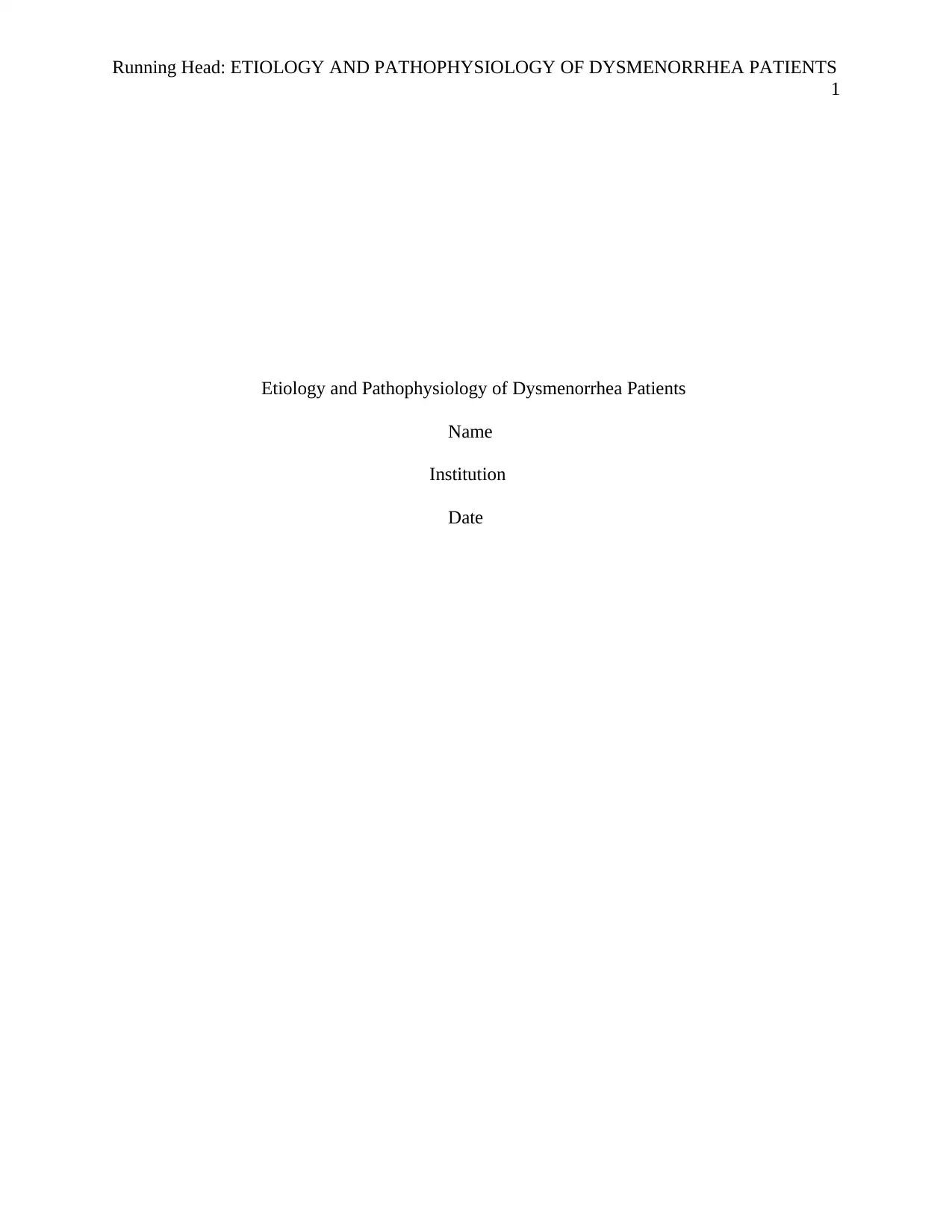
Running Head: ETIOLOGY AND PATHOPHYSIOLOGY OF DYSMENORRHEA PATIENTS
1
Etiology and Pathophysiology of Dysmenorrhea Patients
Name
Institution
Date
1
Etiology and Pathophysiology of Dysmenorrhea Patients
Name
Institution
Date
Secure Best Marks with AI Grader
Need help grading? Try our AI Grader for instant feedback on your assignments.
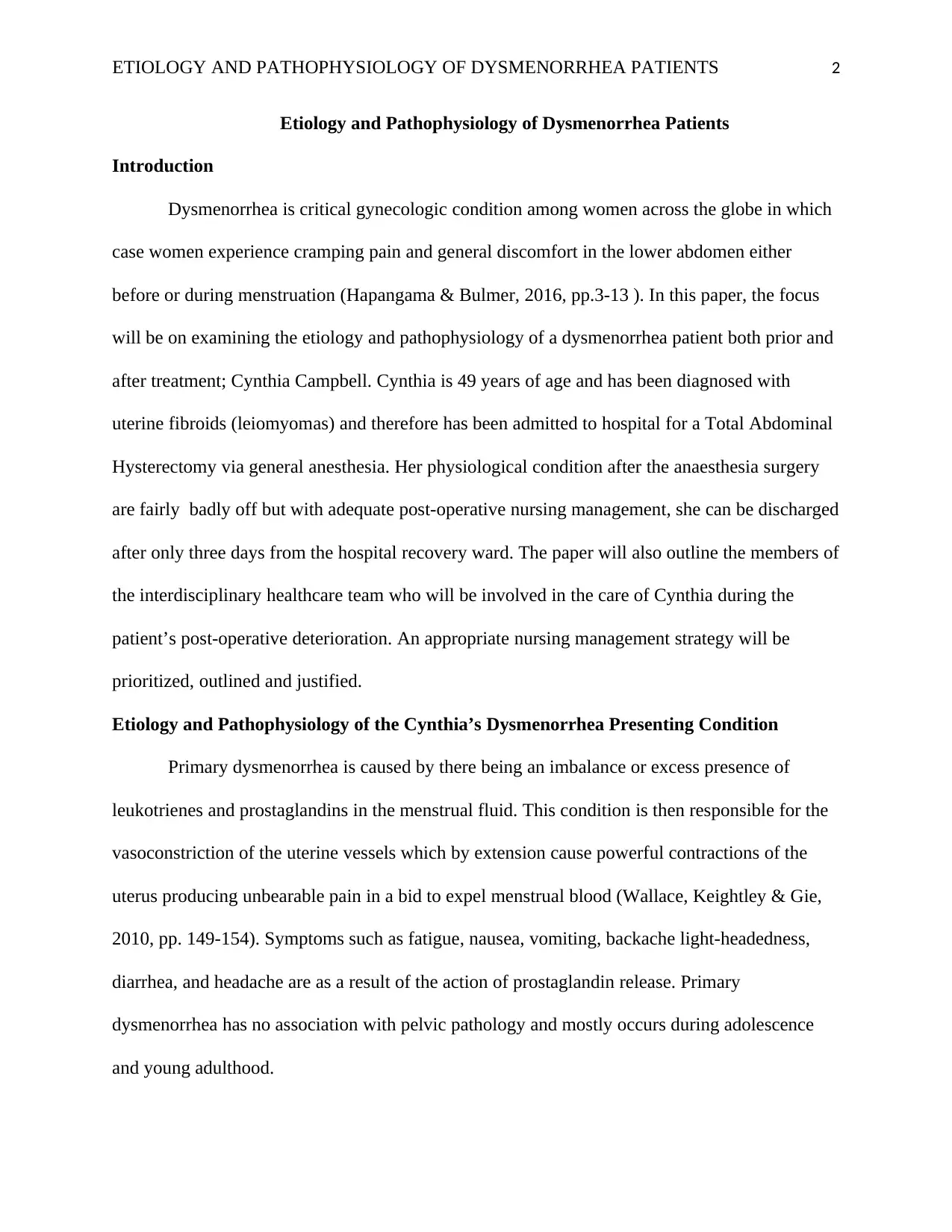
ETIOLOGY AND PATHOPHYSIOLOGY OF DYSMENORRHEA PATIENTS 2
Etiology and Pathophysiology of Dysmenorrhea Patients
Introduction
Dysmenorrhea is critical gynecologic condition among women across the globe in which
case women experience cramping pain and general discomfort in the lower abdomen either
before or during menstruation (Hapangama & Bulmer, 2016, pp.3-13 ). In this paper, the focus
will be on examining the etiology and pathophysiology of a dysmenorrhea patient both prior and
after treatment; Cynthia Campbell. Cynthia is 49 years of age and has been diagnosed with
uterine fibroids (leiomyomas) and therefore has been admitted to hospital for a Total Abdominal
Hysterectomy via general anesthesia. Her physiological condition after the anaesthesia surgery
are fairly badly off but with adequate post-operative nursing management, she can be discharged
after only three days from the hospital recovery ward. The paper will also outline the members of
the interdisciplinary healthcare team who will be involved in the care of Cynthia during the
patient’s post-operative deterioration. An appropriate nursing management strategy will be
prioritized, outlined and justified.
Etiology and Pathophysiology of the Cynthia’s Dysmenorrhea Presenting Condition
Primary dysmenorrhea is caused by there being an imbalance or excess presence of
leukotrienes and prostaglandins in the menstrual fluid. This condition is then responsible for the
vasoconstriction of the uterine vessels which by extension cause powerful contractions of the
uterus producing unbearable pain in a bid to expel menstrual blood (Wallace, Keightley & Gie,
2010, pp. 149-154). Symptoms such as fatigue, nausea, vomiting, backache light-headedness,
diarrhea, and headache are as a result of the action of prostaglandin release. Primary
dysmenorrhea has no association with pelvic pathology and mostly occurs during adolescence
and young adulthood.
Etiology and Pathophysiology of Dysmenorrhea Patients
Introduction
Dysmenorrhea is critical gynecologic condition among women across the globe in which
case women experience cramping pain and general discomfort in the lower abdomen either
before or during menstruation (Hapangama & Bulmer, 2016, pp.3-13 ). In this paper, the focus
will be on examining the etiology and pathophysiology of a dysmenorrhea patient both prior and
after treatment; Cynthia Campbell. Cynthia is 49 years of age and has been diagnosed with
uterine fibroids (leiomyomas) and therefore has been admitted to hospital for a Total Abdominal
Hysterectomy via general anesthesia. Her physiological condition after the anaesthesia surgery
are fairly badly off but with adequate post-operative nursing management, she can be discharged
after only three days from the hospital recovery ward. The paper will also outline the members of
the interdisciplinary healthcare team who will be involved in the care of Cynthia during the
patient’s post-operative deterioration. An appropriate nursing management strategy will be
prioritized, outlined and justified.
Etiology and Pathophysiology of the Cynthia’s Dysmenorrhea Presenting Condition
Primary dysmenorrhea is caused by there being an imbalance or excess presence of
leukotrienes and prostaglandins in the menstrual fluid. This condition is then responsible for the
vasoconstriction of the uterine vessels which by extension cause powerful contractions of the
uterus producing unbearable pain in a bid to expel menstrual blood (Wallace, Keightley & Gie,
2010, pp. 149-154). Symptoms such as fatigue, nausea, vomiting, backache light-headedness,
diarrhea, and headache are as a result of the action of prostaglandin release. Primary
dysmenorrhea has no association with pelvic pathology and mostly occurs during adolescence
and young adulthood.

ETIOLOGY AND PATHOPHYSIOLOGY OF DYSMENORRHEA PATIENTS 3
At the onset of ovulatory cycles approximately six months to one year after the menarche
is when Primary dysmenorrhoea strikes. Pain may last between 24 and 72 hours. Cervical
stenosis which is the expulsion of large nonliquefied clots and the misalignment of the pelvic
girdle, ligaments, and vertebrae due to the general position of the uterus in the pelvic cavity are
grey causes of both primary and secondary dysmenorrhea (Kajihara, et al. 2011, pp. 73-79).
Though Cynthia’s dysmenorrhea condition cannot be concluded to be of a primary dysmenorrhea
nature, primary dysmenorrhea can by and large lead to serious secondary dysmenorrhea
Cynthia is a middle aged woman and therefore her dysmenorrhea condition is by and
large of a secondary nature. In a sharp contrast to primary dysmenorrhea, pelvic pathology is a
critical aspect in secondary dysmerrhoea. Older women may have had pelvic infections during
their younger age. Pelvic infections cause adhesions which by extension envelop the ovaries as
well as occluding the fallopian tubes resulting in hydrosalpinges. Hydrosalpinges is connected to
symptoms such as dyspareunia, infertility, postcoital bleeding, dysuria, dyschezia and general
disturbances of the menstrual cycle. Endometriosis which is the presence of ectopic endometrial
tissue within the peritoneal cavity is by and large the commonest pathophysiological process
associated with secondary dyspareunia (Wodlin, et al, 2011, pp. 369-379). Endometriosis pelvic
pain can either be cyclic or non-cyclic with menstruation and may be further associated with a
fixed and retroverted uterus. Menstruation pain from endometriosis can be compounded by the
simultaneous occurrence of Adenomyosis (myometrium infiltration by endometrial cells).
Adenomyosis is associated with intermenstrual bleeding and clinical physical findings on the
patient comprise of an enlarged, tender boggy uterus.
Moreover, and as in the case of Cynthia, uterine fibroids have been established to cause
uterine enlargement and possess strong associations with menorrhagia which is responsible for
At the onset of ovulatory cycles approximately six months to one year after the menarche
is when Primary dysmenorrhoea strikes. Pain may last between 24 and 72 hours. Cervical
stenosis which is the expulsion of large nonliquefied clots and the misalignment of the pelvic
girdle, ligaments, and vertebrae due to the general position of the uterus in the pelvic cavity are
grey causes of both primary and secondary dysmenorrhea (Kajihara, et al. 2011, pp. 73-79).
Though Cynthia’s dysmenorrhea condition cannot be concluded to be of a primary dysmenorrhea
nature, primary dysmenorrhea can by and large lead to serious secondary dysmenorrhea
Cynthia is a middle aged woman and therefore her dysmenorrhea condition is by and
large of a secondary nature. In a sharp contrast to primary dysmenorrhea, pelvic pathology is a
critical aspect in secondary dysmerrhoea. Older women may have had pelvic infections during
their younger age. Pelvic infections cause adhesions which by extension envelop the ovaries as
well as occluding the fallopian tubes resulting in hydrosalpinges. Hydrosalpinges is connected to
symptoms such as dyspareunia, infertility, postcoital bleeding, dysuria, dyschezia and general
disturbances of the menstrual cycle. Endometriosis which is the presence of ectopic endometrial
tissue within the peritoneal cavity is by and large the commonest pathophysiological process
associated with secondary dyspareunia (Wodlin, et al, 2011, pp. 369-379). Endometriosis pelvic
pain can either be cyclic or non-cyclic with menstruation and may be further associated with a
fixed and retroverted uterus. Menstruation pain from endometriosis can be compounded by the
simultaneous occurrence of Adenomyosis (myometrium infiltration by endometrial cells).
Adenomyosis is associated with intermenstrual bleeding and clinical physical findings on the
patient comprise of an enlarged, tender boggy uterus.
Moreover, and as in the case of Cynthia, uterine fibroids have been established to cause
uterine enlargement and possess strong associations with menorrhagia which is responsible for

ETIOLOGY AND PATHOPHYSIOLOGY OF DYSMENORRHEA PATIENTS 4
causing dysmenorrhea (Edlund, 2009, pp.12-33). Endometrium structural pathology like polyps
is also responsible for cycle disturbances which then lead to pain during menstruation. It is also
possible to contract dysmenorrhea through various congenital uterine anomalies such as
unicornuate uterus with a noncommunicating rudimentary uterine cornu as well as cervical
stenosis. The pelvic inflammatory disease in which case patients are observed to have cervical
motion tenderness, adnexal tenderness, and uterine tenderness may also be a big time cause of
secondary dysmenorrhea.
Cynthia has also been diagnosed to possess a mild history of depression possibly due to
loneliness fallowing her husband’s death and children away. Psychosocial factors such as
depression are potential conditions for the worsening of the chronic pelvic pain. Like in primary
dysmenorrhea, secondary dysmenorrhea is characterized by lower abdomen ache, depression,
headache, and fatigue. This may begin way before ovulation and extend several days to the next
menses.
Underlying Pathophysiology of the Cynthia’s Post-Operative Deterioration
Like what is expected of a Total Abdominal Hysterectomy and more so in the case of a
general anaesthesia, Cynthia is supposed to stay in the ward for at least three days so that
healthcare practitioners can monitor her for any discomfort, pain, and infections (Reeve &
Boden, 2016). Cynthia’s general physiological functions are by and large badly off from the
norm but they can significantly be improved causing no need for panic. Her respiratory rate of 30
breaths per minute is way higher than what is expected of a normal adult respiratory rate of 12 to
16 breaths per minute.
Her blood pressure of 90/50mmHg is lower than the normal 120/80mmHg and therefore
it needs to improve. Her pulse rate of 130bpm is way high as such a rate is for children between
causing dysmenorrhea (Edlund, 2009, pp.12-33). Endometrium structural pathology like polyps
is also responsible for cycle disturbances which then lead to pain during menstruation. It is also
possible to contract dysmenorrhea through various congenital uterine anomalies such as
unicornuate uterus with a noncommunicating rudimentary uterine cornu as well as cervical
stenosis. The pelvic inflammatory disease in which case patients are observed to have cervical
motion tenderness, adnexal tenderness, and uterine tenderness may also be a big time cause of
secondary dysmenorrhea.
Cynthia has also been diagnosed to possess a mild history of depression possibly due to
loneliness fallowing her husband’s death and children away. Psychosocial factors such as
depression are potential conditions for the worsening of the chronic pelvic pain. Like in primary
dysmenorrhea, secondary dysmenorrhea is characterized by lower abdomen ache, depression,
headache, and fatigue. This may begin way before ovulation and extend several days to the next
menses.
Underlying Pathophysiology of the Cynthia’s Post-Operative Deterioration
Like what is expected of a Total Abdominal Hysterectomy and more so in the case of a
general anaesthesia, Cynthia is supposed to stay in the ward for at least three days so that
healthcare practitioners can monitor her for any discomfort, pain, and infections (Reeve &
Boden, 2016). Cynthia’s general physiological functions are by and large badly off from the
norm but they can significantly be improved causing no need for panic. Her respiratory rate of 30
breaths per minute is way higher than what is expected of a normal adult respiratory rate of 12 to
16 breaths per minute.
Her blood pressure of 90/50mmHg is lower than the normal 120/80mmHg and therefore
it needs to improve. Her pulse rate of 130bpm is way high as such a rate is for children between
Secure Best Marks with AI Grader
Need help grading? Try our AI Grader for instant feedback on your assignments.

ETIOLOGY AND PATHOPHYSIOLOGY OF DYSMENORRHEA PATIENTS 5
one and two years. She is supposed to normalize at 60 to 100 bpm. However, her temperatures
levels of 36.50C and pain levels of 0/10 are fine. Moreover, the urine output under indwelling
urinary catheter of 10 mls for the last one hour after the operation is nearing normal urine output
while the moderate oozing out of haemoserous indicate normal healing process. By and large,
Cynthia is not in any great danger given her ward presentation conditions.
A hysterectomy is generally safe and very few women complain of post-operative
deterioration of the same. However, having undergone a Total Abdominal Hysterectomy via
general anaesthesia, Cynthia is still vulnerable to a post-operative deterioration of her major
physiological processes. Cynthia is most likely to feel groggy and confused with anaesthesia’s
major side effects being sleepiness, dizziness, nausea, shivering, vomiting, and sore throat
(Elvan, et al. 2008, pp.357-364). Postoperative Nausea and Vomiting (PONV) has been labeled
as one of the most eminent pathophysiology presentations after an Anesthesia operation.
Cynthia is also likely to experience depression as in the case of a post-traumatic depression
having been operated out of her consciousness. Other underlying pathophysiology outcomes of
anaesthesia may include heart attack, stroke, and pneumonia. Wang et al. (2016) warn that a
Total Abdominal Hysterectomy exposes patients to surgical injuries to bowel and bladder or a
major blood vessel, urinary tract infections, post operation blood clots, excessive bleeding, and
anesthesia.
Cynthia Nursing Management at the Recovery Ward
Routine post anaesthetic observations are critical in the management of patients given
that they can easily suffer from clinical deterioration. The institution of an efficient nursing
management at this time can significantly mitigate various pathophysiology symptoms (Mei, et
al, 2010, pp. 149). For Cynthia’s case, I can prioritize the use of a ViCTOR chart to recognize
one and two years. She is supposed to normalize at 60 to 100 bpm. However, her temperatures
levels of 36.50C and pain levels of 0/10 are fine. Moreover, the urine output under indwelling
urinary catheter of 10 mls for the last one hour after the operation is nearing normal urine output
while the moderate oozing out of haemoserous indicate normal healing process. By and large,
Cynthia is not in any great danger given her ward presentation conditions.
A hysterectomy is generally safe and very few women complain of post-operative
deterioration of the same. However, having undergone a Total Abdominal Hysterectomy via
general anaesthesia, Cynthia is still vulnerable to a post-operative deterioration of her major
physiological processes. Cynthia is most likely to feel groggy and confused with anaesthesia’s
major side effects being sleepiness, dizziness, nausea, shivering, vomiting, and sore throat
(Elvan, et al. 2008, pp.357-364). Postoperative Nausea and Vomiting (PONV) has been labeled
as one of the most eminent pathophysiology presentations after an Anesthesia operation.
Cynthia is also likely to experience depression as in the case of a post-traumatic depression
having been operated out of her consciousness. Other underlying pathophysiology outcomes of
anaesthesia may include heart attack, stroke, and pneumonia. Wang et al. (2016) warn that a
Total Abdominal Hysterectomy exposes patients to surgical injuries to bowel and bladder or a
major blood vessel, urinary tract infections, post operation blood clots, excessive bleeding, and
anesthesia.
Cynthia Nursing Management at the Recovery Ward
Routine post anaesthetic observations are critical in the management of patients given
that they can easily suffer from clinical deterioration. The institution of an efficient nursing
management at this time can significantly mitigate various pathophysiology symptoms (Mei, et
al, 2010, pp. 149). For Cynthia’s case, I can prioritize the use of a ViCTOR chart to recognize
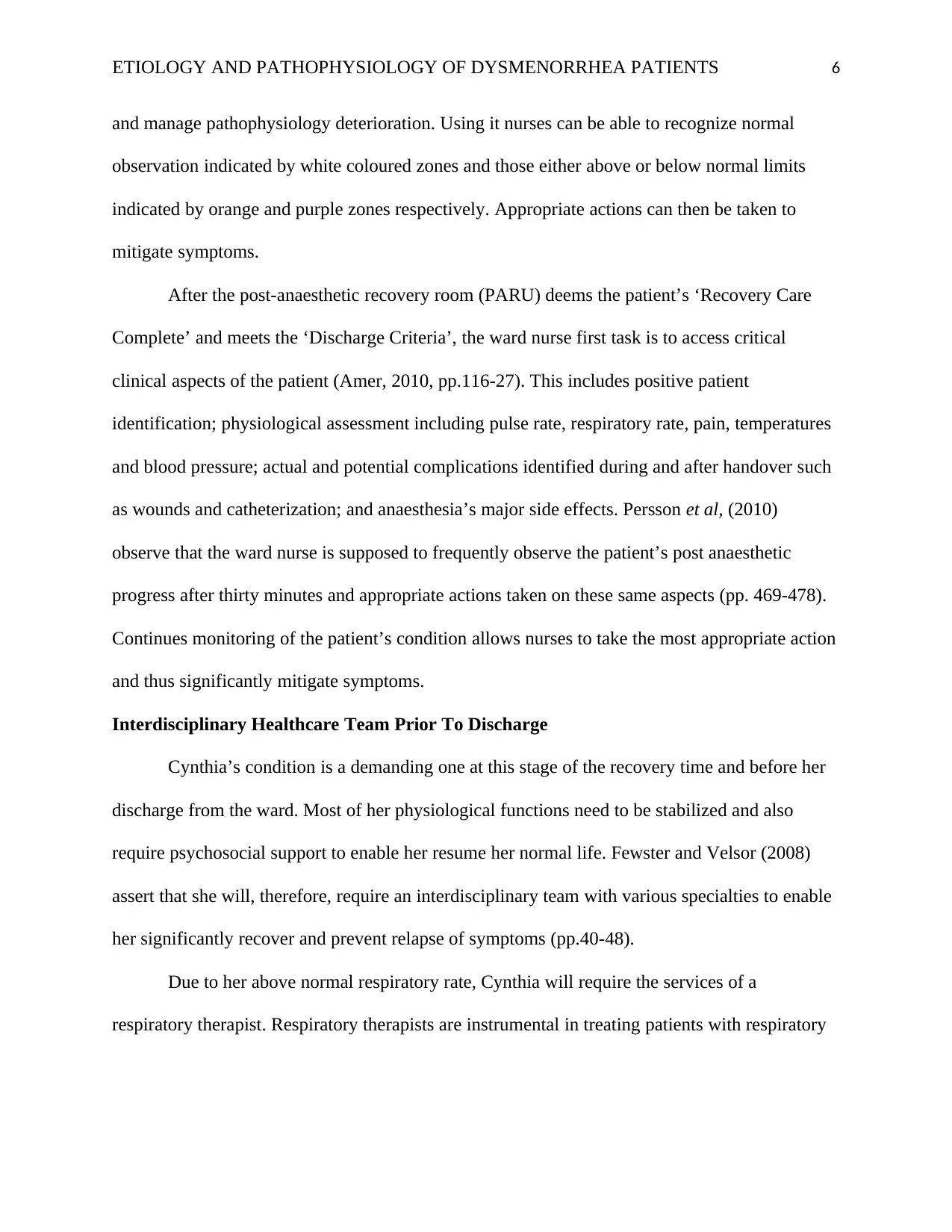
ETIOLOGY AND PATHOPHYSIOLOGY OF DYSMENORRHEA PATIENTS 6
and manage pathophysiology deterioration. Using it nurses can be able to recognize normal
observation indicated by white coloured zones and those either above or below normal limits
indicated by orange and purple zones respectively. Appropriate actions can then be taken to
mitigate symptoms.
After the post-anaesthetic recovery room (PARU) deems the patient’s ‘Recovery Care
Complete’ and meets the ‘Discharge Criteria’, the ward nurse first task is to access critical
clinical aspects of the patient (Amer, 2010, pp.116-27). This includes positive patient
identification; physiological assessment including pulse rate, respiratory rate, pain, temperatures
and blood pressure; actual and potential complications identified during and after handover such
as wounds and catheterization; and anaesthesia’s major side effects. Persson et al, (2010)
observe that the ward nurse is supposed to frequently observe the patient’s post anaesthetic
progress after thirty minutes and appropriate actions taken on these same aspects (pp. 469-478).
Continues monitoring of the patient’s condition allows nurses to take the most appropriate action
and thus significantly mitigate symptoms.
Interdisciplinary Healthcare Team Prior To Discharge
Cynthia’s condition is a demanding one at this stage of the recovery time and before her
discharge from the ward. Most of her physiological functions need to be stabilized and also
require psychosocial support to enable her resume her normal life. Fewster and Velsor (2008)
assert that she will, therefore, require an interdisciplinary team with various specialties to enable
her significantly recover and prevent relapse of symptoms (pp.40-48).
Due to her above normal respiratory rate, Cynthia will require the services of a
respiratory therapist. Respiratory therapists are instrumental in treating patients with respiratory
and manage pathophysiology deterioration. Using it nurses can be able to recognize normal
observation indicated by white coloured zones and those either above or below normal limits
indicated by orange and purple zones respectively. Appropriate actions can then be taken to
mitigate symptoms.
After the post-anaesthetic recovery room (PARU) deems the patient’s ‘Recovery Care
Complete’ and meets the ‘Discharge Criteria’, the ward nurse first task is to access critical
clinical aspects of the patient (Amer, 2010, pp.116-27). This includes positive patient
identification; physiological assessment including pulse rate, respiratory rate, pain, temperatures
and blood pressure; actual and potential complications identified during and after handover such
as wounds and catheterization; and anaesthesia’s major side effects. Persson et al, (2010)
observe that the ward nurse is supposed to frequently observe the patient’s post anaesthetic
progress after thirty minutes and appropriate actions taken on these same aspects (pp. 469-478).
Continues monitoring of the patient’s condition allows nurses to take the most appropriate action
and thus significantly mitigate symptoms.
Interdisciplinary Healthcare Team Prior To Discharge
Cynthia’s condition is a demanding one at this stage of the recovery time and before her
discharge from the ward. Most of her physiological functions need to be stabilized and also
require psychosocial support to enable her resume her normal life. Fewster and Velsor (2008)
assert that she will, therefore, require an interdisciplinary team with various specialties to enable
her significantly recover and prevent relapse of symptoms (pp.40-48).
Due to her above normal respiratory rate, Cynthia will require the services of a
respiratory therapist. Respiratory therapists are instrumental in treating patients with respiratory
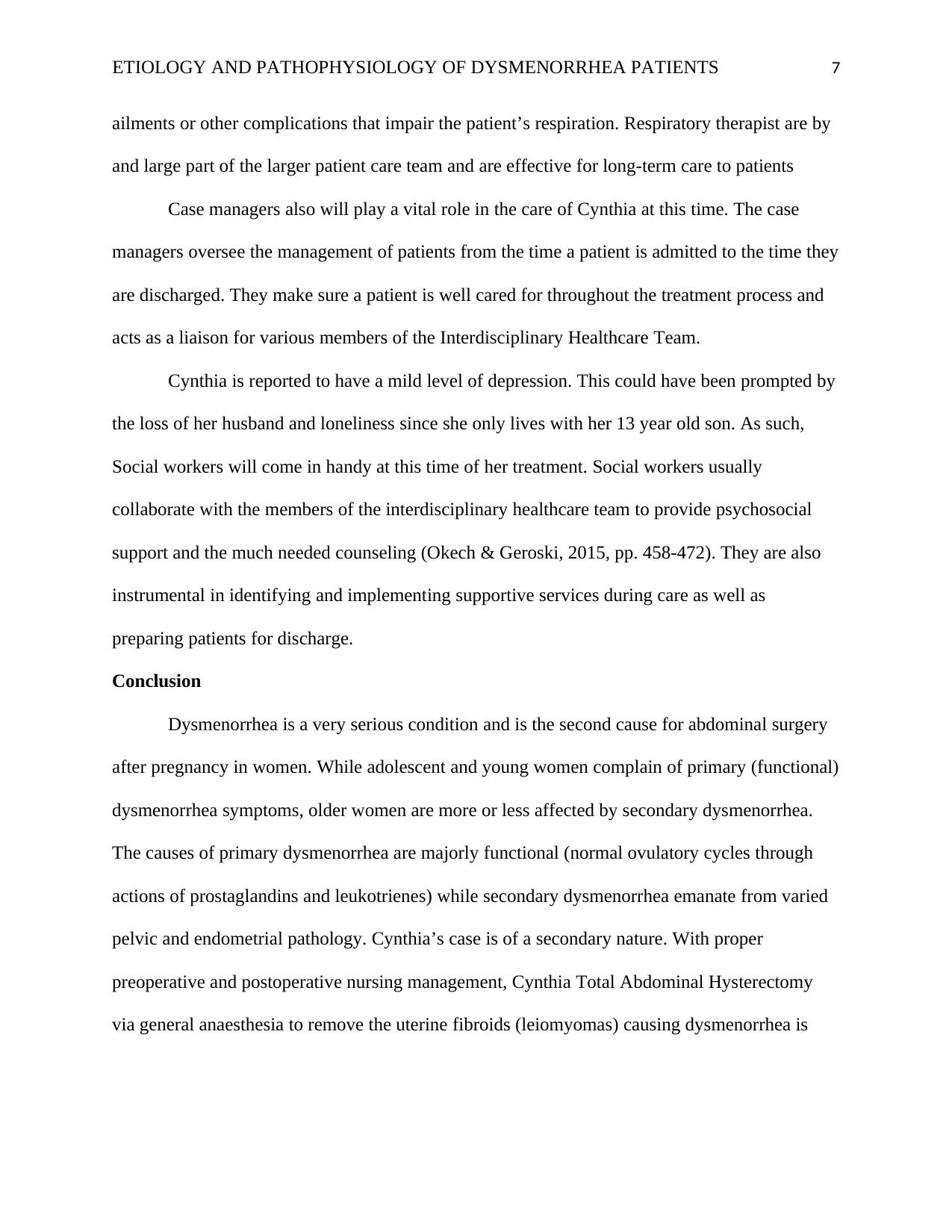
ETIOLOGY AND PATHOPHYSIOLOGY OF DYSMENORRHEA PATIENTS 7
ailments or other complications that impair the patient’s respiration. Respiratory therapist are by
and large part of the larger patient care team and are effective for long-term care to patients
Case managers also will play a vital role in the care of Cynthia at this time. The case
managers oversee the management of patients from the time a patient is admitted to the time they
are discharged. They make sure a patient is well cared for throughout the treatment process and
acts as a liaison for various members of the Interdisciplinary Healthcare Team.
Cynthia is reported to have a mild level of depression. This could have been prompted by
the loss of her husband and loneliness since she only lives with her 13 year old son. As such,
Social workers will come in handy at this time of her treatment. Social workers usually
collaborate with the members of the interdisciplinary healthcare team to provide psychosocial
support and the much needed counseling (Okech & Geroski, 2015, pp. 458-472). They are also
instrumental in identifying and implementing supportive services during care as well as
preparing patients for discharge.
Conclusion
Dysmenorrhea is a very serious condition and is the second cause for abdominal surgery
after pregnancy in women. While adolescent and young women complain of primary (functional)
dysmenorrhea symptoms, older women are more or less affected by secondary dysmenorrhea.
The causes of primary dysmenorrhea are majorly functional (normal ovulatory cycles through
actions of prostaglandins and leukotrienes) while secondary dysmenorrhea emanate from varied
pelvic and endometrial pathology. Cynthia’s case is of a secondary nature. With proper
preoperative and postoperative nursing management, Cynthia Total Abdominal Hysterectomy
via general anaesthesia to remove the uterine fibroids (leiomyomas) causing dysmenorrhea is
ailments or other complications that impair the patient’s respiration. Respiratory therapist are by
and large part of the larger patient care team and are effective for long-term care to patients
Case managers also will play a vital role in the care of Cynthia at this time. The case
managers oversee the management of patients from the time a patient is admitted to the time they
are discharged. They make sure a patient is well cared for throughout the treatment process and
acts as a liaison for various members of the Interdisciplinary Healthcare Team.
Cynthia is reported to have a mild level of depression. This could have been prompted by
the loss of her husband and loneliness since she only lives with her 13 year old son. As such,
Social workers will come in handy at this time of her treatment. Social workers usually
collaborate with the members of the interdisciplinary healthcare team to provide psychosocial
support and the much needed counseling (Okech & Geroski, 2015, pp. 458-472). They are also
instrumental in identifying and implementing supportive services during care as well as
preparing patients for discharge.
Conclusion
Dysmenorrhea is a very serious condition and is the second cause for abdominal surgery
after pregnancy in women. While adolescent and young women complain of primary (functional)
dysmenorrhea symptoms, older women are more or less affected by secondary dysmenorrhea.
The causes of primary dysmenorrhea are majorly functional (normal ovulatory cycles through
actions of prostaglandins and leukotrienes) while secondary dysmenorrhea emanate from varied
pelvic and endometrial pathology. Cynthia’s case is of a secondary nature. With proper
preoperative and postoperative nursing management, Cynthia Total Abdominal Hysterectomy
via general anaesthesia to remove the uterine fibroids (leiomyomas) causing dysmenorrhea is
Paraphrase This Document
Need a fresh take? Get an instant paraphrase of this document with our AI Paraphraser

ETIOLOGY AND PATHOPHYSIOLOGY OF DYSMENORRHEA PATIENTS 8
bound to extend her relief from pathophysiology symptoms in both phases (Calderon, Castorena,
& Pasic, 2012, pp. 269-279).
bound to extend her relief from pathophysiology symptoms in both phases (Calderon, Castorena,
& Pasic, 2012, pp. 269-279).
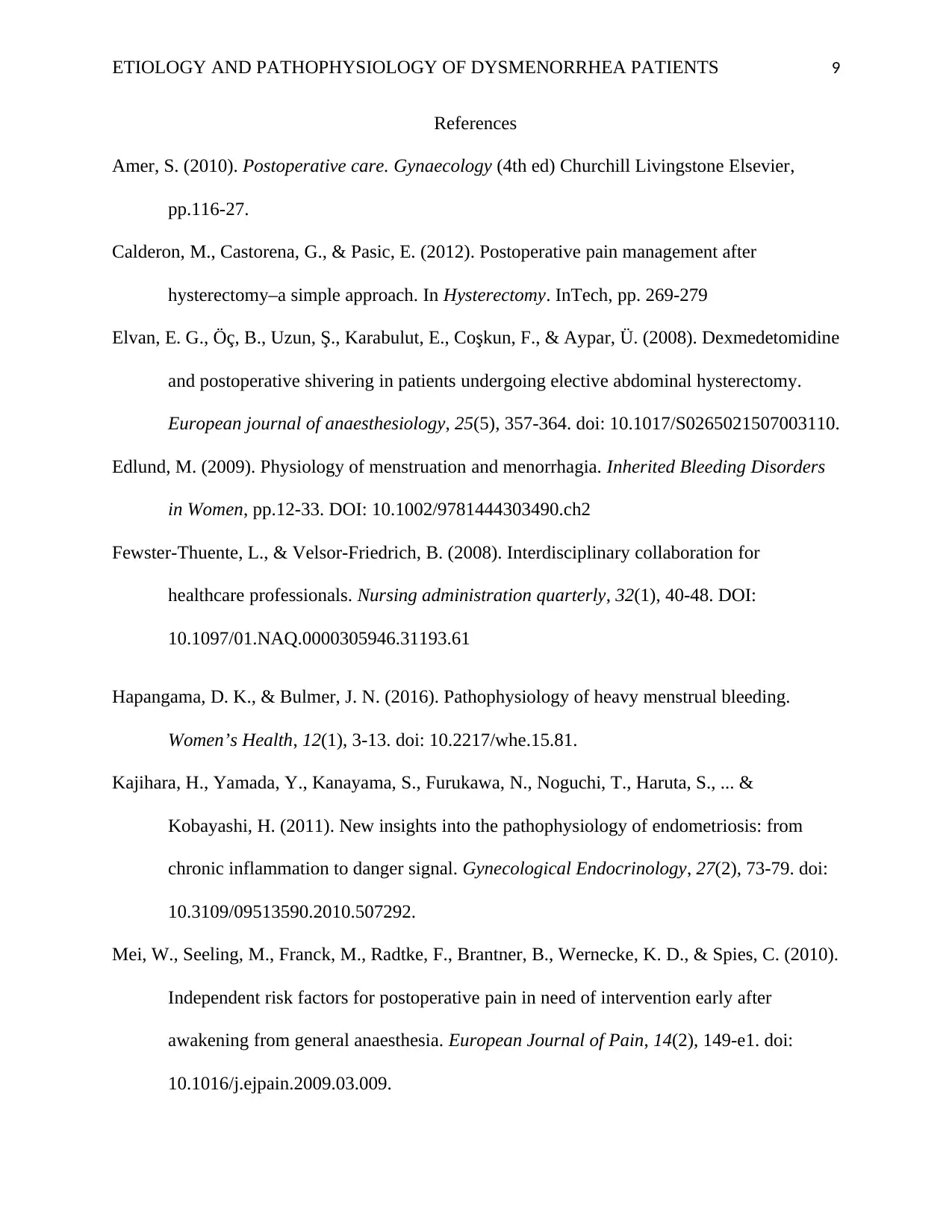
ETIOLOGY AND PATHOPHYSIOLOGY OF DYSMENORRHEA PATIENTS 9
References
Amer, S. (2010). Postoperative care. Gynaecology (4th ed) Churchill Livingstone Elsevier,
pp.116-27.
Calderon, M., Castorena, G., & Pasic, E. (2012). Postoperative pain management after
hysterectomy–a simple approach. In Hysterectomy. InTech, pp. 269-279
Elvan, E. G., Öç, B., Uzun, Ş., Karabulut, E., Coşkun, F., & Aypar, Ü. (2008). Dexmedetomidine
and postoperative shivering in patients undergoing elective abdominal hysterectomy.
European journal of anaesthesiology, 25(5), 357-364. doi: 10.1017/S0265021507003110.
Edlund, M. (2009). Physiology of menstruation and menorrhagia. Inherited Bleeding Disorders
in Women, pp.12-33. DOI: 10.1002/9781444303490.ch2
Fewster-Thuente, L., & Velsor-Friedrich, B. (2008). Interdisciplinary collaboration for
healthcare professionals. Nursing administration quarterly, 32(1), 40-48. DOI:
10.1097/01.NAQ.0000305946.31193.61
Hapangama, D. K., & Bulmer, J. N. (2016). Pathophysiology of heavy menstrual bleeding.
Women’s Health, 12(1), 3-13. doi: 10.2217/whe.15.81.
Kajihara, H., Yamada, Y., Kanayama, S., Furukawa, N., Noguchi, T., Haruta, S., ... &
Kobayashi, H. (2011). New insights into the pathophysiology of endometriosis: from
chronic inflammation to danger signal. Gynecological Endocrinology, 27(2), 73-79. doi:
10.3109/09513590.2010.507292.
Mei, W., Seeling, M., Franck, M., Radtke, F., Brantner, B., Wernecke, K. D., & Spies, C. (2010).
Independent risk factors for postoperative pain in need of intervention early after
awakening from general anaesthesia. European Journal of Pain, 14(2), 149-e1. doi:
10.1016/j.ejpain.2009.03.009.
References
Amer, S. (2010). Postoperative care. Gynaecology (4th ed) Churchill Livingstone Elsevier,
pp.116-27.
Calderon, M., Castorena, G., & Pasic, E. (2012). Postoperative pain management after
hysterectomy–a simple approach. In Hysterectomy. InTech, pp. 269-279
Elvan, E. G., Öç, B., Uzun, Ş., Karabulut, E., Coşkun, F., & Aypar, Ü. (2008). Dexmedetomidine
and postoperative shivering in patients undergoing elective abdominal hysterectomy.
European journal of anaesthesiology, 25(5), 357-364. doi: 10.1017/S0265021507003110.
Edlund, M. (2009). Physiology of menstruation and menorrhagia. Inherited Bleeding Disorders
in Women, pp.12-33. DOI: 10.1002/9781444303490.ch2
Fewster-Thuente, L., & Velsor-Friedrich, B. (2008). Interdisciplinary collaboration for
healthcare professionals. Nursing administration quarterly, 32(1), 40-48. DOI:
10.1097/01.NAQ.0000305946.31193.61
Hapangama, D. K., & Bulmer, J. N. (2016). Pathophysiology of heavy menstrual bleeding.
Women’s Health, 12(1), 3-13. doi: 10.2217/whe.15.81.
Kajihara, H., Yamada, Y., Kanayama, S., Furukawa, N., Noguchi, T., Haruta, S., ... &
Kobayashi, H. (2011). New insights into the pathophysiology of endometriosis: from
chronic inflammation to danger signal. Gynecological Endocrinology, 27(2), 73-79. doi:
10.3109/09513590.2010.507292.
Mei, W., Seeling, M., Franck, M., Radtke, F., Brantner, B., Wernecke, K. D., & Spies, C. (2010).
Independent risk factors for postoperative pain in need of intervention early after
awakening from general anaesthesia. European Journal of Pain, 14(2), 149-e1. doi:
10.1016/j.ejpain.2009.03.009.
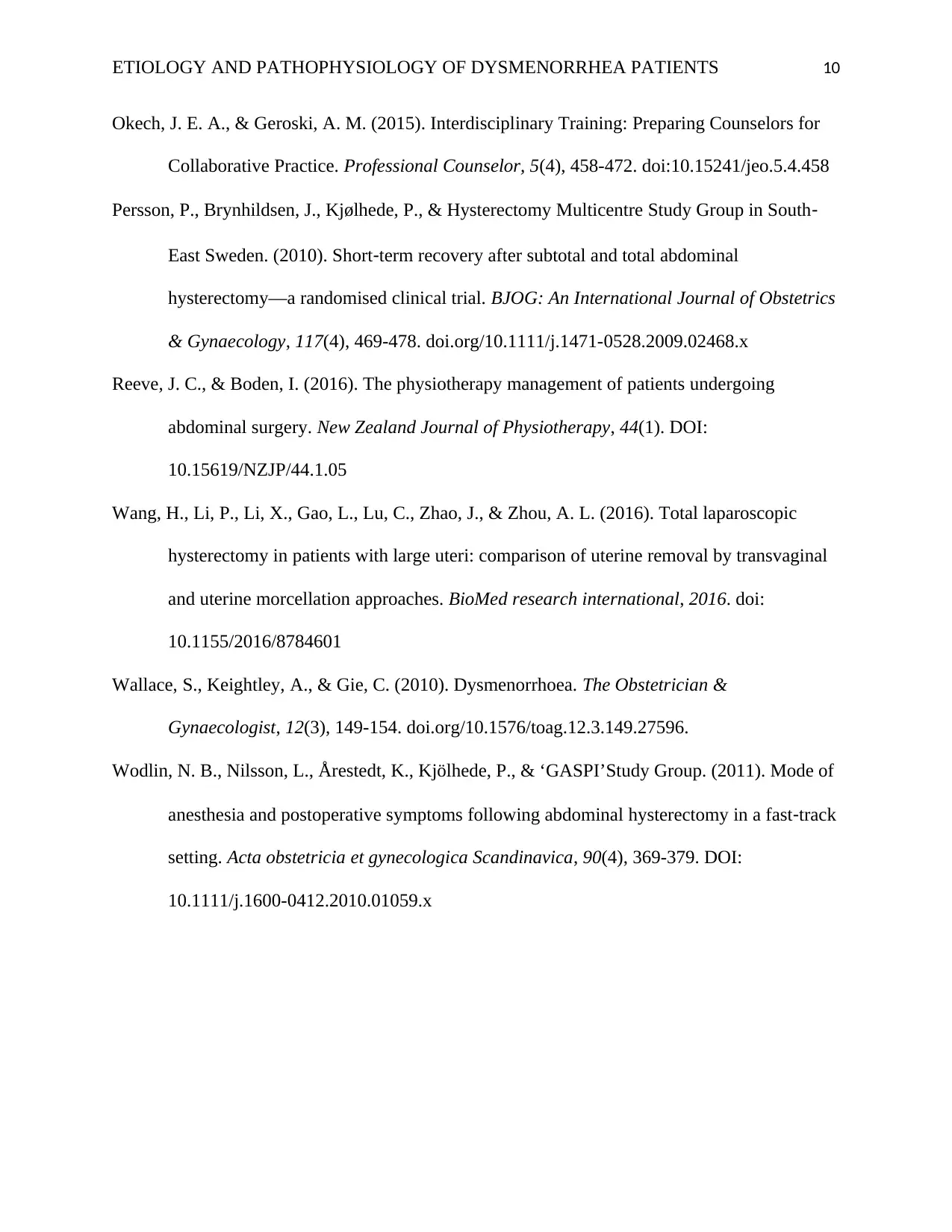
ETIOLOGY AND PATHOPHYSIOLOGY OF DYSMENORRHEA PATIENTS 10
Okech, J. E. A., & Geroski, A. M. (2015). Interdisciplinary Training: Preparing Counselors for
Collaborative Practice. Professional Counselor, 5(4), 458-472. doi:10.15241/jeo.5.4.458
Persson, P., Brynhildsen, J., Kjølhede, P., & Hysterectomy Multicentre Study Group in South‐
East Sweden. (2010). Short‐term recovery after subtotal and total abdominal
hysterectomy—a randomised clinical trial. BJOG: An International Journal of Obstetrics
& Gynaecology, 117(4), 469-478. doi.org/10.1111/j.1471-0528.2009.02468.x
Reeve, J. C., & Boden, I. (2016). The physiotherapy management of patients undergoing
abdominal surgery. New Zealand Journal of Physiotherapy, 44(1). DOI:
10.15619/NZJP/44.1.05
Wang, H., Li, P., Li, X., Gao, L., Lu, C., Zhao, J., & Zhou, A. L. (2016). Total laparoscopic
hysterectomy in patients with large uteri: comparison of uterine removal by transvaginal
and uterine morcellation approaches. BioMed research international, 2016. doi:
10.1155/2016/8784601
Wallace, S., Keightley, A., & Gie, C. (2010). Dysmenorrhoea. The Obstetrician &
Gynaecologist, 12(3), 149-154. doi.org/10.1576/toag.12.3.149.27596.
Wodlin, N. B., Nilsson, L., Årestedt, K., Kjölhede, P., & ‘GASPI’Study Group. (2011). Mode of
anesthesia and postoperative symptoms following abdominal hysterectomy in a fast‐track
setting. Acta obstetricia et gynecologica Scandinavica, 90(4), 369-379. DOI:
10.1111/j.1600-0412.2010.01059.x
Okech, J. E. A., & Geroski, A. M. (2015). Interdisciplinary Training: Preparing Counselors for
Collaborative Practice. Professional Counselor, 5(4), 458-472. doi:10.15241/jeo.5.4.458
Persson, P., Brynhildsen, J., Kjølhede, P., & Hysterectomy Multicentre Study Group in South‐
East Sweden. (2010). Short‐term recovery after subtotal and total abdominal
hysterectomy—a randomised clinical trial. BJOG: An International Journal of Obstetrics
& Gynaecology, 117(4), 469-478. doi.org/10.1111/j.1471-0528.2009.02468.x
Reeve, J. C., & Boden, I. (2016). The physiotherapy management of patients undergoing
abdominal surgery. New Zealand Journal of Physiotherapy, 44(1). DOI:
10.15619/NZJP/44.1.05
Wang, H., Li, P., Li, X., Gao, L., Lu, C., Zhao, J., & Zhou, A. L. (2016). Total laparoscopic
hysterectomy in patients with large uteri: comparison of uterine removal by transvaginal
and uterine morcellation approaches. BioMed research international, 2016. doi:
10.1155/2016/8784601
Wallace, S., Keightley, A., & Gie, C. (2010). Dysmenorrhoea. The Obstetrician &
Gynaecologist, 12(3), 149-154. doi.org/10.1576/toag.12.3.149.27596.
Wodlin, N. B., Nilsson, L., Årestedt, K., Kjölhede, P., & ‘GASPI’Study Group. (2011). Mode of
anesthesia and postoperative symptoms following abdominal hysterectomy in a fast‐track
setting. Acta obstetricia et gynecologica Scandinavica, 90(4), 369-379. DOI:
10.1111/j.1600-0412.2010.01059.x
Secure Best Marks with AI Grader
Need help grading? Try our AI Grader for instant feedback on your assignments.

ETIOLOGY AND PATHOPHYSIOLOGY OF DYSMENORRHEA PATIENTS 11
1 out of 11
Related Documents
Your All-in-One AI-Powered Toolkit for Academic Success.
+13062052269
info@desklib.com
Available 24*7 on WhatsApp / Email
![[object Object]](/_next/static/media/star-bottom.7253800d.svg)
Unlock your academic potential
© 2024 | Zucol Services PVT LTD | All rights reserved.





